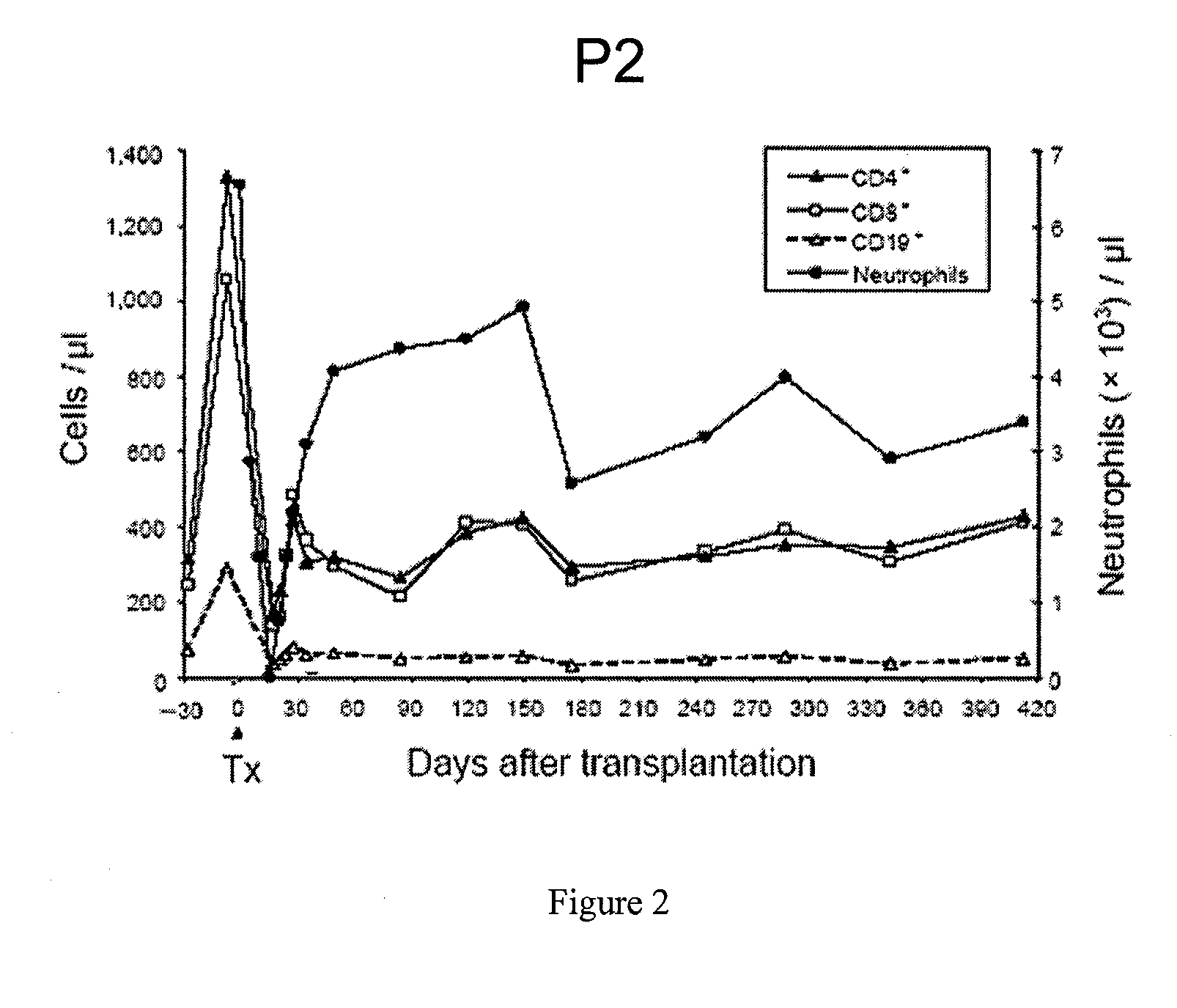Stem and progenitor cell expansion by evi, evi-like genes and setbp1
a progenitor cell and stem cell technology, applied in the field of stem and progenitor cell expansion by evi, evilike genes and setbp1, can solve the problems of less effective human gene therapy, inability to rapidly expand, and inability to grow gene-corrected cells in culture or in vivo, so as to improve the proliferation rate, increase the proliferation rate, and improve the effect of human cell survival and/or engraftmen
- Summary
- Abstract
- Description
- Claims
- Application Information
AI Technical Summary
Benefits of technology
Problems solved by technology
Method used
Image
Examples
example 1
Description of the Vector and Gene Transfer Protocol for Treatment of the 2 Successfully-Treated CGD Patients Receiving Gene Therapy
[0112]For the construction of the retroviral vector SF71gp91phox the pSF71 backbone [Hildinger, M. et al. FMEV vectors: both retroviral long terminal repeat and leader are important for high expression in transduced hematopoietic cells. Gene Ther 5, 1575-1579 (1998), herein incorporated by reference in its entirety] was used, in which the coding region of gp91phox was inserted by standard molecular cloning. In this vector, gp91phox expression is driven by the Friend mink cell Spleen focus-forming virus (SFFV) LTR, which has been shown to be highly active in stem and myeloid progenitor cells [Baum, C. et al. Novel retroviral vectors for efficient expression of the multidrug resistance (mdr-1) gene in early hematopoietic cells. J Virol 69, 7541-7547 (1995), herein incorporated by reference in its entirety]. Vector containing supernatants were obtained fro...
example 2
Description of the Gp91phox PCR Method
[0115]The ABI PRISM 7700 Sequence Detection System (PE Applied Biosystems, Weiterstadt, Germany) was used to determine the presence of proviral sequences in genomic DNA isolated from the blood and bone marrow cells of patients P1 and P2. The exon 8 primer gp91-f (5′-GGTTTTGGCGATCTC AACAGAA-3′) (SEQ ID NO: 1) and exon 9 primer gp91-r (5′-TGTATTGTCCCACTTCCATTTTGAA-3′) (SEQ ID NO: 2) were used to amplify a 114-bp fragment of the gp91phox cDNA. Amplification was detected with the FAM-labelled probe gp91-p (5′-TCATCACCAAGGTGGTC ACTCACCCTTTC-3′) (SEQ ID NO: 3). The human EPO receptor gene was used as an internal control to quantify the gp91phox reaction. Primers hepo-f (5′-CTGCTGCCAGC TTTGAGTACACTA-3′) (SEQ ID NO: 4) and hepo-r (5′-GAGATGCCAGAGTCAGATACCACAA-3′) (SEQ ID NO: 5) amplified a 138-bp fragment from exon 8 of the EPO-receptor-gene. Amplification was determined by the VIC-labelled probe hepo-p (5′-ACCCCAGCT CCCAGCTCTTGCGT-3′) (SEQ ID NO: 6). B...
example 3
Integration Site Analysis by the Linear Amplification Mediated (LAM)-PCR Method
[0116]100 ng of DNA from peripheral blood leukocytes was used for integration site analysis that was performed by LAM PCR as previously described (Schmidt, et al. (2002) Blood 100:2737-2743; Schmidt, et al. (2003) Nature Med. 9:463-468, each of the foregoing which is hereby incorporated by reference in its entirety) but biotinylated primer LTR I (5′>GTT TGG CCC AAC GTT AGC TAT Tst and 2nd exponential PCR amplification, vector specific primers LTR II (5′>GCC CTT GAT CTG AAC TTC TCTTC CAT GCC TTG CAA AAT GGCGAC CCG GGA GAT CTG AAT TC3′) (SEQ ID NO: 16) and LC II (5′>GAT CTG AAT TCA GTG GCA CAG<3′) (SEQ ID NO: 17), respectively. LAM-PCR amplicons were purified, shotgun cloned into the TOPO TA vector (Invitrogen, Carlsbad, Calif.) and sequenced (GATC, Konstanz, Germany). Sequences were aligned to the human genome (hg17, release 35, May 2004) using the UCSC BLAT genome browser (available on the world wide web ...
PUM
| Property | Measurement | Unit |
|---|---|---|
| Fraction | aaaaa | aaaaa |
| Fraction | aaaaa | aaaaa |
| Fraction | aaaaa | aaaaa |
Abstract
Description
Claims
Application Information
 Login to View More
Login to View More - R&D
- Intellectual Property
- Life Sciences
- Materials
- Tech Scout
- Unparalleled Data Quality
- Higher Quality Content
- 60% Fewer Hallucinations
Browse by: Latest US Patents, China's latest patents, Technical Efficacy Thesaurus, Application Domain, Technology Topic, Popular Technical Reports.
© 2025 PatSnap. All rights reserved.Legal|Privacy policy|Modern Slavery Act Transparency Statement|Sitemap|About US| Contact US: help@patsnap.com



